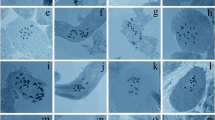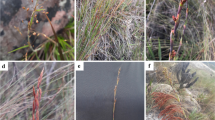Abstract
Chromosome number and other cytological features are reported from 35 species ofVelloziaceae, including several African and Brazilian populations. All analyzed species show areticulate interphase nuclei and prophase/prometaphase chromosomes with proximal early condensation. Most heteropycnotic blocks do not seem to correspond to heterochromatin since, at least inVellozia patens, they do not stain differentially after C-banding procedures. Regarding the chromosome number, three main groups could be identified. The first comprised diploid species of the generaNanuza, Vellozia and the Brazilian species ofXerophyta with 2n = 14 or 16; the second comprised tetraploid species with 2n = 34, and included all Brazilian species of subfam.Barbacenioideae; the third group, of hexaploid species, comprised the African representatives of the genusXerophyta. A single population ofVellozia, possibly of hybrid origin, had 2n ≅ 32. A basic number of x = 8 is proposed for the family. The karyological information supports the hypothesis that theVelloziaceae originated on the South American, rather than on the African continent.
Similar content being viewed by others
References
Ayensu, E. S., 1973: Phytogeography and evolution of theVelloziaceae. — InMeggers, B. J., Ayensu, E. S., Duckworth, W. D., (Eds): Tropical forest ecosystems in Africa and South America: comparative review, pp. 105–119. — Washington: Smithsonian Institution Press.
Barlow, P., 1977: Determinants of nuclear chromatin structure in angiosperms. — Ann. Sci. Nat. Bot., 12e Sér.,18: 193–206.
Cronquist, A., 1988: The evolution and classification of flowering plants. — New York: New York Botanical Garden.
Dahlgren, R., 1977: A commentary on a diagrammatic presentation of the angiosperms in relation to the distribution of character states. — Pl. Syst. Evol., Suppl.1: 253–283.
Delay, C., 1949: Recherches sur la structure des noyaux quiescents chez les phanérogames. — Ph.D. Thesis. Paris.
Deumling, B., Greilhuber, J., 1982: Characterization of heterochromatin in different species of theScilla siberica group (Liliaceae) by in situ hybridization of satellite DNAs and fluorochrome banding. — Chromosoma84: 535–555.
Ehrendorfer, F., 1980: Polyploidy and distribution. — InLewis, W. H., (Ed.): Polyploidy — biological relevance, pp. 45–60. — New York, London: Plenum Press.
Favarger, C., 1978: Philosophie des comptages de chromosomes. — Taxon27: 441–448.
Goldblatt, P., 1980: Polyploidy in angiosperms: monocotyledons. — InLewis, W. H., (Ed.): Polyploidy—biological relevance, pp. 219–239. — New York, London: Plenum Press.
—, 1988: Observations on the chromosome cytology ofVelloziaceae. — Ann. Missouri Bot. Gard.75: 192–195.
Grant, V., 1981: Plant speciation, 2nd edn. — New York: Columbia University Press.
Greilhuber, J., Ehrendorfer, F., 1988: Karyological approaches to plant taxonomy. — ISI Atlas of Science: Animal Pl. Sci.1: 289–297.
Guerra, M., 1983: O uso do Giemsa na citogenética vegetal—comparação entre a coloração simples e o bandeamento. — Ci. & Cult.35: 190–193.
—, 1987: Cytogenetics ofRutaceae IV. Structure and systematic significance of interphase nuclei. — Cytologia52: 213–222.
—, 1988: Characterization of different types of condensed chromatin inCostus (Zingiberaceae). — Pl. Syst. Evol.158: 107–115.
Harborne, J. B., Williams, C. A., Greenham, J., Eagles, J., 1994: Variations in the lipophilic and vacuolar flavonoids of the genusVellozia. — Phytochemistry35: 1475.
Hutchinson, J., 1934: The families of flowering plants, 2. Monocotyledons. — London: Macmillan.
Levin, D. A., Funderburg, S. W., 1979: Genome size in angiosperms: temperate versus tropical species. — Amer. Naturalist114: 784–795.
Lewis, W. H., 1980: Polyploidy in plant evolution: summary. — InLewis, W. H., (Ed.): Polyploidy — biological relevance, pp. 241–268. — New York: Plenum Press.
Mello-Silva, R. de, 1991: The infra-familial taxonomic circumscription of theVelloziaceae: a historical and critical analysis. — Taxon40: 45–51.
Menezes, N. L., 1971: New taxa and new combinations inVelloziaceae. — Ci. & Cult.23: 421–422.
—, 1980: Evolution inVelloziaceae, with special reference to androecial characters. — InBrickell, C. D., Cutler, D. F., Gregory, M., (Eds): Petaloid monocotyledons. — Linn. Soc. Symp. Ser.8: 117–138.
—, 1988: Evolution of the anther in the familyVelloziaceae. — Bol. Bot. Univ. São Paulo10: 33–41.
—, 1991:Burlemarxia, a new genus ofVelloziaceae. — Taxon40: 413–426.
—, 1994: A cladistic analysis of theVelloziaceae. — Kew Bull.49: 71–92.
Morawetz, W., 1988: Karyosystematics and evolution of AustralianAnnonaceae as compared withEupomatiaceae, Himantandraceae andAustrobaileyaceae. — Pl. Syst. Evol.159: 49–79.
Raven, P. H., 1975: The bases of angiosperm phylogeny: cytology. — Ann. Missouri Bot. Gard.62: 724–764.
Salatino, M. L. F., Salatino, A., Menezes, N. L., Mello-Silva, R. de, 1989: Alkanes of foliar epicuticular waxes ofVelloziaceae. — Phytochemistry28: 1105–1114.
Schwarzacher, T., Ambros, P., Schweizer, D., 1980: Application of Giemsa banding to orchid karyotype analysis. — Pl. Syst. Evol.134: 293–297.
Schweizer, D., 1976: Reverse fluorescent chromosome banding with chromomycin and DAPI. — Chromosoma58: 307–324.
Sharma, A. K., 1984: Chromosome evolution in the monocotyledons—an overview. — InSharma, A. K., Sharma, A., (Eds): Chromosome evolution in eucaryotic groups II: 169–187. — Boca Raton: CRC Press.
—, 1971: I. Cytotaxonomy of the familyBromeliaceae. — Cytologia36: 237–247.
Smith, L. B., Ayensu, E. S., 1976: A revision of AmericanVelloziaceae. — Smithsonian Contrib. Bot.30: 1–172. — Washington: Smithsonian Institution Press.
Stebbins, G. L., 1971: Chromosomal evolution in higher plants. — London: Arnold.
Stenar, A. H. S., 1925: Embryologische Studien II. Embryologie der Amaryllideen. — Ph.D. Thesis, Uppsala.
Takhtajan, 1969: Flowering plants: origin and dispersal (translated from Russian byJefrey, G. C.). — Washington, D. C.: Smithsonian Institution Press.
Williams, C. A., Harborne, J. B., Tomas-Barberan, F. A., 1987: Biflavonoids in the primitive monocotsIsophysis tasmanica andXerophyta plicata. — Phytochemistry26: 2553–2555.
—, 1994: Differences in flavonoid patterns between genera within theVelloziaceae. — Phytochemistry36: 931–940.
Author information
Authors and Affiliations
Rights and permissions
About this article
Cite this article
Franklin de Melo, N., Guerra, M., Benko-Iseppon, A.M. et al. Cytogenetics and cytotaxonomy ofVelloziaceae . Pl Syst Evol 204, 257–273 (1997). https://doi.org/10.1007/BF00989209
Received:
Revised:
Accepted:
Issue Date:
DOI: https://doi.org/10.1007/BF00989209




